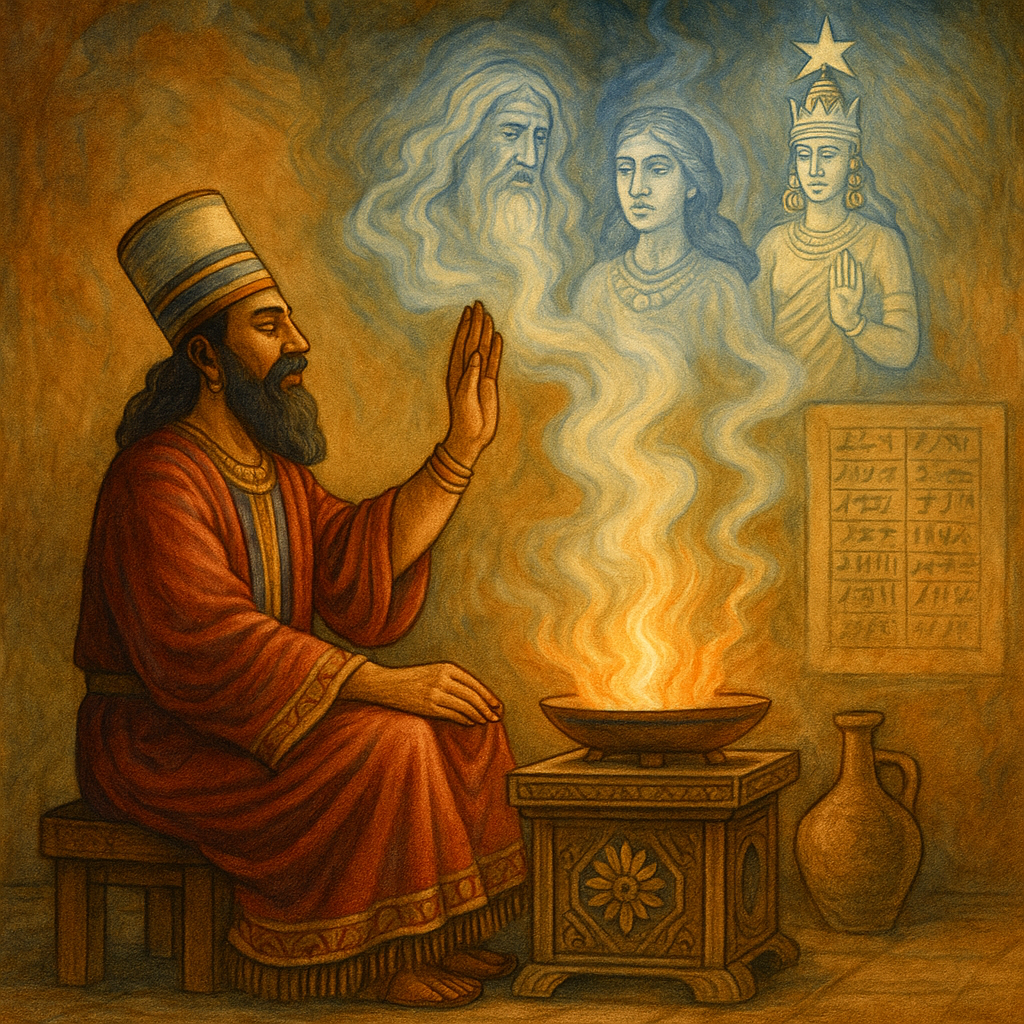Babylonian Beliefs: Spirit Communication, Mediumship, and Spiritual Dimensions
Introduction
The Babylonians, inheritors of the wider Mesopotamian spiritual tradition, developed a complex worldview where humans, gods, and spirits were in constant interaction. They believed that life was shaped not only by earthly actions but also by unseen spiritual dimensions. Spirit communication and forms of mediumship were essential for maintaining harmony, seeking protection, and understanding divine will.
Babylonian Cosmology: A Universe of Many Realms
Babylonian religion described a multi-layered cosmos, structured by order (šipru) and the will of the gods:
Earthly Realm (Ki): Human life surrounded by divine influence.
Heavens (Anu’s Realm): The domain of gods and celestial powers, associated with stars and planets.
Underworld (Irkalla): Ruled by Ereshkigal, where the dead resided in shadowy existence.
Watery Abyss (Apsu and Tiamat): Primordial chaos and source of creation.
This cosmology reinforced the need for ritual specialists and mediums to mediate between humans and these dimensions.
Spirit Communication in Babylonian Traditions
1. Priests as Mediums
Priests (āšipu and bārû) acted as ritual specialists, mediating between gods, spirits, and humans.
Āšipu (Exorcists): Specialists in magical rituals and incantations, who communicated with spirits to expel evil forces.
Bārû (Diviners): Interpreted omens, dreams, and celestial signs as messages from the gods.
2. Dreams as Divine Messages
Dreams were considered a primary channel of communication with the gods and the dead.
Temples offered rituals of dream incubation, where petitioners sought divine visions during sleep.
Kings and priests recorded dream omens to guide political and military decisions.
3. Necromancy and Ancestor Communication
The Babylonians practiced kispu rituals, offering food and drink to ancestral spirits (etemmu).
Necromancers could summon the dead to seek guidance or avert misfortune.
Ancestors were believed to bring blessings when honored, or illness and unrest when neglected.
Spirits, Gods, and Entities in Communication
Etemmu (Ghosts): Spirits of the dead who lingered in the underworld or returned to haunt the living.
Lamashtu and Pazuzu: Powerful spirits associated with illness or protection.
Gods (Ilu): Deities like Marduk, Ishtar, and Shamash communicated through oracles, omens, and dreams.
Demons and Protective Spirits: Rituals sought to expel harmful beings and invite benevolent ones for healing and safety.
Techniques of Spirit Contact
The Babylonians developed a variety of ritual practices to communicate across dimensions:
Incantations and Exorcisms: Priests used sacred words, amulets, and ritual objects to invoke or banish spirits.
Divination: Reading the liver of sacrificed animals (extispicy), star charts, and omens as divine communication.
Dream Incubation: Sleeping in temples to receive direct visions from gods or ancestors.
Offerings (Kispu): Food and drink provided to the dead during monthly rites, strengthening bonds with ancestors.
Necromancy: Ritual summoning of spirits for counsel or resolution of disputes.
Mediumship and Community Life
Spirit communication was not limited to priests and kings—ordinary families honored ancestors through household shrines.
Mediumship in Babylonian culture was pragmatic, focused on protection, healing, and maintaining balance.
Festivals and public rituals often included possession-like states, where worshippers embodied gods or spirits through ecstatic ritual.
Comparisons with Western Mediumship
Similarities: Use of trance, dreams, necromancy, ancestor offerings, and divination.
Differences: Babylonian spirit communication was institutionalized and ritualized, led by priests and integrated into state religion. Unlike Western séances, it emphasized cosmic order, divine will, and ancestral duty over individual survival proof.
Continuity and Legacy
Though Babylonian religion declined with the rise of later empires, its influence endures:
Babylonian astrology and dream interpretation shaped Greek, Roman, and modern traditions.
Rituals of exorcism, necromancy, and ancestor veneration continued in Near Eastern and Mediterranean cultures.
Modern fascination with Mesopotamian deities like Ishtar and Marduk reflects ongoing interest in Babylonian spiritual dimensions.
Conclusion
Babylonian beliefs in spirit communication, mediumship, and multidimensional realms reveal a culture where gods, spirits, and the dead remained actively involved in human life. Through dreams, necromancy, offerings, and divination, Babylonians sustained an ongoing dialogue with the unseen.
Unlike Western Spiritualism, Babylonian practices were institutional, pragmatic, and deeply tied to cosmic order, ensuring harmony between humans and the vast spiritual universe.

